Home /
Expert Answers /
Earth Sciences /
unconformities-unconformities-are-gaps-in-the-geologic-record-that-result-from-erosion-or-non-depo-pa390
(Solved): Unconformities Unconformities are gaps in the geologic record that result from erosion or non-depo ...
Unconformities Unconformities are gaps in the geologic record that result from erosion or non-deposition and separate younger rocks above the unconformity from older rocks below the unconformity. Unconformities are surfaces representing intervals of geologic time during which no rocks formed, erosion occurred, or both. Unconformities nearly always form on dry land above sea level. The process by which rocks are brought above sea level is generally called uplift, while the process by which they are returned back beneath sea level is called subsidence. Unconformities are represented by wavy lines on block diagrams. The 3 types of unconformities are: Angular Unconformity: A surface separating inclined rock layers below from less inclined/horizontal rock layers above the erosional surface. This indicates the rocks below the erosional surface experienced some folding that exposed multiple layers to the surface, allowing for erosion of those layers, and then deposition of younger sediment on top of the eroded surface. Nonconformity: A surface that separates igneous/metamorphic crystalline rocks below from younger sedimentary rocks above the erosional surface. Igneous and metamorphic rocks usually form deep within Earth's crust, so a nonconformity indicates a period of uplift to bring the rocks to the surface and erosion to expose them so that sediment could be deposited on top of them. Disconformity: A surface that separates parallel sedimentary rock units directly above and below the unconformity. Instructions: For each of the diagrams in this lab, put the units in order from oldest to youngest, with the oldest listed at the bottom and the youngest at the top (in accordance with the Principle of Superposition). Then answer the questions about each diagram. You may need to reference previous labs/the textbook for refreshing your memory on rock types and environments of formation. The geologic time scale from your textbook has been included in this lab module for your convenience.
Diagram 1 F K B H J D A C Figure 9, pg. 249, Ludman and Marshak, 2013, Laboratory Manual for Introductory Geology 2. What type of unconformity is present in this diagram? Youngest Oldest 1. Place the units in this diagram in order from oldest to youngest. You may do this by writing the units in the blanks along the side of the diagram or listing them in order below (oldest at the bottom, youngest at the top). 3. What 2 principles of relative age dating allow you to determine the relative age of unit C? 4. Geologists have determined that unit D is an ancient lava flow with a mafic composition. What rock name and texture would you expect this unit to have? 5. If unit D is 176 million years old, and unit B is 60 million years old, then how old is unit J?

